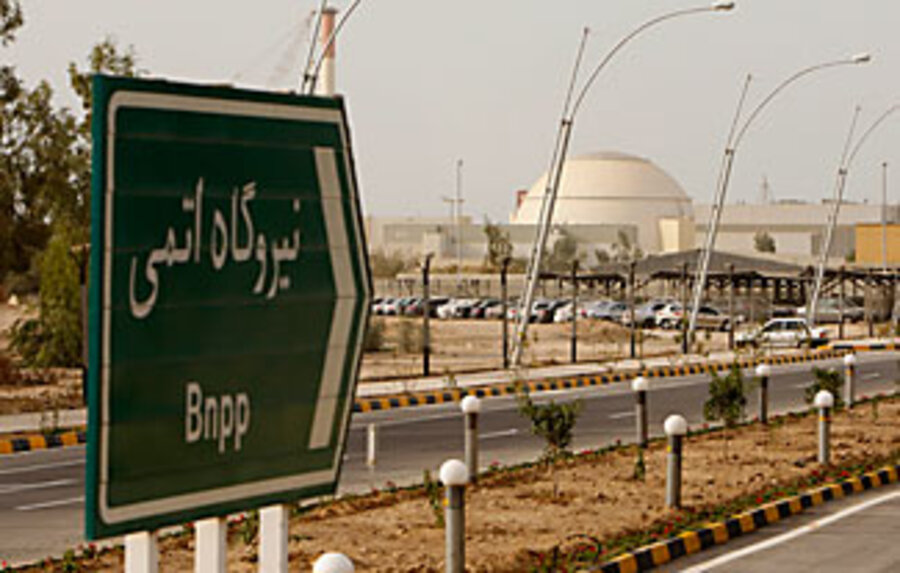Timeline: Iran's reach for nuclear power
1957: The US and Iran sign a civilian nuclear cooperation pact. The US provides technical aid and several kilograms of enriched uranium to help the country build its first nuclear reactor.
1974: The shah, encouraged by the US to diversify Iran's energy resources, launches a program to build 23 nuclear reactors.
Mid-1970s: The Iranian government receives nuclear assistance from other nations, including France, West Germany, India, and South Africa.
1979: The Islamic revolution overthrows the shah. Nuclear cooperation with the West ends. Tehran decides it doesn't need nuclear energy. Around this time, the US says it has intelligence that the shah had set up a clandestine program to develop nuclear weapons.
1984-1988: During the Iran-Iraq War, Baghdad bombs Iran's two nuclear reactors at Bushehr. Iran resumes its interest in a national nuclear program. In 1985, the Islamic Republic, together with Libya and Syria, says they should all develop nuclear weapons to counter the Israeli nuclear threat.
1995: Russia signs a deal with Iran to build a lightweight water reactor at Bushehr, under international safeguards.
2002: Iranian exiles report the existence of a facility to enrich uranium – required for nuclear weapons – at Natanz and a heavy-water plant at Arak. Three months later, bolstered by satellite photos, the US accuses Iran of pursuing weapons of mass destruction.
2003: Iran agrees to suspend producing enriched uranium and allow tougher UN inspections. In a report, the International Atomic Energy Agency (IAEA) accuses Iran of failure to comply with international safeguards, but finds "no evidence" of an attempt to build a bomb. Bush officials call the verdict "impossible" to believe.
2004: During talks with three European Union nations, Iran agrees to stop all enrichment activity again, but pledges to resume it in the future.
2005: Iran announces plans in April to resume uranium enrichment. In August, hard-liner Mahmoud Ahmadinejad becomes president, further fraying ties with the West. Iran resumes uranium conversion, arguing it is for peaceful purposes only.
2006: The IAEA votes to report Iran to the UN Security Council. Iran cuts off snap UN inspections of nuclear facilities. Late in the year, the Security Council passes a resolution imposing sanctions on Iran for its enrichment activities.
2007: The Security Council broadens UN sanctions against Iran. Diplomats say the country has installed 3,000 centrifuges, enough to begin refining usable amounts of nuclear fuel. The US imposes new sanctions on Iran. A US intelligence analysis finds that Iran halted its nuclear weapons program in 2003, but other spy agencies, including in Britain, doubt the assessment.
2008: The UN adopts its third sanctions resolution against Iran. The IAEA expresses serious concern over Iran's research into nuclear warheads. Iran test-fires nine medium- and long-range missiles in the Gulf. Iranian officials rule out a freeze in uranium enrichment during talks in Geneva. An informal deadline passes for Iran to respond to an offer from the West and Russia for new talks.
2009: Russia says it plans to start up a nuclear reactor at Bushehr by the end of 2009. An IAEA report shows a significant increase in Iran's reported stockpile of low-enriched uranium. New US President Obama calls for "honest" engagement with Tehran. Iran welcomes the overture, but wants to see "practical steps." In June, Ahmadinejad is reelected president. In September, Iran says it is ready to resume talks with world powers. Iran agrees to a proposal to send most of its low-enriched uranium to Russia for processing. In mid-November, Iran signals it is rejecting the Western-backed idea. Sources: The Center for Arms Control and Non-Proliferation, Reuters






